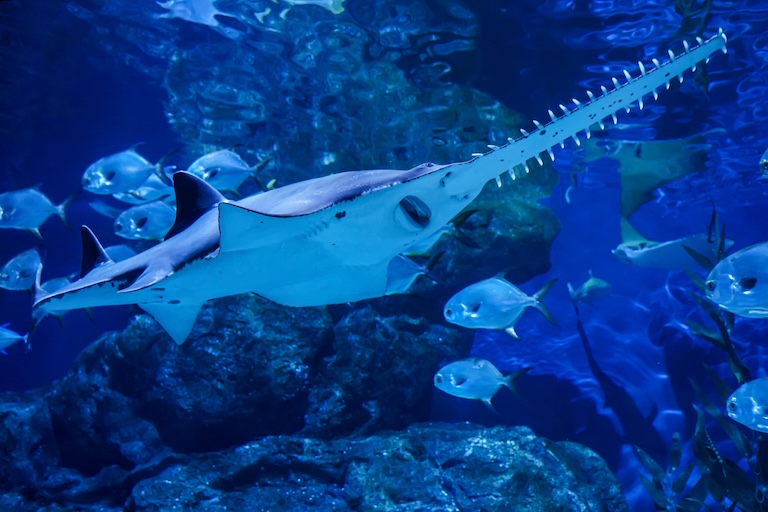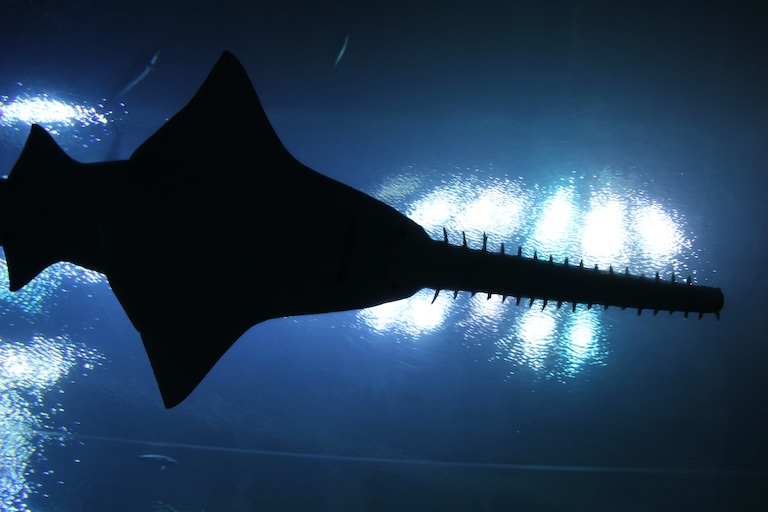Largetooth Sawfish Profile
Sometime around 1500 AD, the Archbishop of Uppsala, Olaus Magnus, wrote “A Compendious History of the Goths, Svvedes, & Vandals, and Other Northern Nations”, in which he detailed – among pretty much everything else – “Rarities and Observable of all the Four Elements; but especially the ripping up of the Bowels and Internals of Nature..”
In it, was a description of the sawfish, which reads,
“The saw fish is also a beast of the sea; the body is huge and great, the head hath a crest and is hard and dented like a saw. It will swim under ships and cut them, that the water may come in, and he may feed on the men when the ship is drowned.”

Largetooth Sawfish Facts Overview
| Habitat: | Wetlands, marine, inter-tidal, coastal |
| Location: | Northern South America, Central America, West Africa, SE Asia, Australia |
| Lifespan: | Unknown, possibly 40 – 80 years |
| Size: | Up to 7.5m (25 ft) long |
| Weight: | Can grow to over 600kg (1300 lb) |
| Colour: | Sandy brown with white belly |
| Diet: | Fish, molluscs, crustaceans |
| Predators: | Sharks, saltwater crocs |
| Top Speed: | Slow |
| No. of Species: | 1 |
| Conservation Status: | Critically Endangered (IUCN) |
Largetooth sawfish are much bigger, heavier and more powerful versions of the other three members of their genus, carrying, as they all do, a long and toothed snout that looks like it would be useful for topiary.
They’re rays, despite looking like and being named after, sharks, and they grow to enormous and peculiar proportions. This has led to them being killed directly to use their snouts as a trophy or in medicine, or indirectly as bycatch, to the point where they are almost extinct with few viable populations left.
Interesting Largetooth Sawfish Facts
1. Half shark, half ray?
The sawfishes are a very strange-looking bunch. Aside from the obvious frontal appendage, they have wings like a ray and a body a bit like a shark. They even have another name, Carpenter Sharks, which doesn’t do them any favours, either.
It’s no coincidence that they’re in the class of cartilaginous fishes, but despite being formidable predators of fish, they aren’t all that closely related to sharks.
Sawfishes sit firmly in the order of Batoidea, with the rays. There are four species in the Pristis genus: the Smalltooth, (which is better for cutting metal), the Green, the Dwarf, and this magnificent animal, the largetooth sawfish, one of the biggest fish in the world.
Sadly, every single species is critically endangered.

2. They grow into their noses
Of course, they aren’t born enormous, they have to work up to it. Much like puppies are all legs and ears until the rest of their body catches up, juvenile sawfish have disproportionately long noses.
When a sawfish is just a little hack, its elongated rostrum makes up about 30% of its length. In the largetooth, this saw is wider than in others, hence the name, and as the animal grows, the ratio of nose-to-body moves away from that of a British monarch and towards that of an elephant: closer to 20% of its total length.
Contrary to some beliefs, the saw is part of the nose or rostrum. It’s not the mouth, which sits under the animal and looks not unlike the lips of Dr. Frank N. Furter. 1
3. They’re powerful predators
Despite their weird appearance, these are large and powerful hunters. While they’re small, they make do with slower-moving animals like shrimp and crabs, and gradually they work their way up to fish.
The ridiculous weapon on their faces is more than just a saw, it’s also pocketed with thousands of gel-filled pores containing a substance that responds to electricity.
This is their electroreception organ, and the ray uses it like a metal detector, swinging it over the sand to pick up on the tiniest of electrical anomalies that give away the inbuilt pacemakers in the tiny hearts of their prey.
This extra sense allows the sawfish to hunt without sight, and so they often feed at night.
When catching fish, the hedge-trimmer face attachment can be used to great effect to both stun and bifurcate entire groups of otherwise fast-moving prey items, which can then be sucked up by the Rocky Horror mouth. 2
4. They grow slowly
Adult largetooth sawfish are some of the biggest fish in the world and can grow to more than 600kg in weight. They take their sweet time getting to that size, reaching maturity after around ten years old and can live to 35.
This slow growth impacts their population recovery rate, and faced with relentless hunting, they are now critically endangered. 3
5. Their weirdness has caused them a lot of harm
Due to their odd appearance, they’ve been common curiosities to humanity for at least thousands of years. They occupy a place in religious and spiritual ceremonies in several cultures around the world, and of course, in traditional medicine.
The teeth have been used to strap to fighting cocks (the bird kind) to give them an edge against their opponents, and being a huge meaty fish, they’re also eaten.
Their fins make a bland yet ostentatious soup that very wealthy Chinese people go crazy for, and so the animals are also being persecuted for that. Some cultures believe tea made from the saws aids in treating asthma.
6. They’re relatively harmless
Despite Archbishop Olaus Magnus’ hysteria about this animal, they’re no threat to anybody, least of all boats. This is a guy who described sea cows – perhaps the most docile and timid of all floating balloon animals – as “strong, angry and injurious”.
It’s likely he’d never seen one and was only recounting what he’d heard. Which is totally different from what’s happening right now, honest.
There are tales of injuries, and perhaps deaths, occurring as a result of interfering violently with a giant sawfish, and they’re believable to an extent. This is a 600kg animal with enormous slashing muscles and a long, toothed weapon on its head – it’s hard to imagine beating one in a fight.
But you’d have to get into a fight with it in the first place. Unprovoked, the sawfish is considered very docile.
7. Australia may have the only viable population
And for most of us, finding one to fight with would be the biggest hurdle. This poor species has declined to the degree that Australia may be the only place with enough of them to form a viable subpopulation.
It was once recorded in 75 countries and now is only present in about 20. The population around Australia is the only healthy one known (probably on account of it being so difficult for humans to survive the water for long enough to kill a sawfish) but even here, their numbers are dropping.
The Amazon estuary has one significant population, and there’s another in the San Juan system in Central America, but the species now faces depletion all over the world. 4

8. Fishing is the main issue
As you can imagine, if anything’s going to get stuck in a net, it’ll be the toothy rostrum of a sawfish.
Bycatch is a huge problem for the species, in both commercial and small-scale, even subsistence fisheries. These are hard animals to return to the wild, and catch a hefty price on the fin market, so a catch is usually guaranteed death for the ray.
Habitat degradation of mangrove forests and estuarine environments also plays a powerful role in their decline. The larger the fish, the more they’re affected. 5
Largetooth Sawfish Fact-File Summary
Scientific Classification
| Kingdom: | Animalia |
| Phylum: | Chordata |
| Class: | Chondrichthyes |
| Order: | Rhinopristiformes |
| Family: | Pristidae |
| Genus: | Pristis |
| Species: | pristis |
Fact Sources & References
- “Largetooth Sawfish”, Florida Museum.
- ANNE CASSELMAN(2019), “Searching for the world’s last remaining sawfish”, National Geographic.
- “Largetooth sawfish”, National Geographic.
- Joana Fernandez-Carvalho (2013), “Status and the potential for extinction of the largetooth sawfish Pristis pristis in the Atlantic Ocean”, Wiley Online Library.
- “Largetooth Sawfish”, IUCN Red List.
